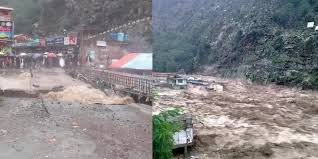By Ziauddin Shah
Gilgit-Baltistan, situated in the northernmost part of Pakistan, is a region with unique ecological characteristics. It has the highest massif of snow-clad mountains, some of the longest glaciers, and over 6,000 lakes. Administered by Islamabad through a colonial bureaucratic system of governance, the region generates a huge amount of revenue for Pakistan in terms of Pak-China border trade, and the much-needed foreign exchange through tourism.

Till the recent past, Gilgit-Baltistan was among the few regions in the world which were famous for longevity because of its clean environment, healthy food, and lifestyle. The locals used to practice agri-pastoral activities for centuries and produce subsistence food in an eco-friendly environment.
Sadly, this practice is now fast fading and people are emigrating from the region to urban centres and becoming dependent on the market. Climate change, neoliberal development, resource capture by the elite and the powerful as well as unbridled mass tourism have posed potential threats to the inhabitants, their society, culture, health, and the fragile ecology of Gilgit-Baltistan.
For the last many years, Gilgit-Baltistan and other regions have been suffering the most from the effects of global warming — a phenomenon the mountain communities are not responsible for – the neoliberal development models and mega projects. The sufferings of the people are compounded by the anti-people policies, bad planning by the rulers, and the state repression for resisting the capture of their resources.
Unprecedented monsoon rains and rise in temperature causes glacial lake outburst floods (GLOF), which in turn trigger flashfloods and landslides which are now commonplace every summer as glaciers and snow are fast melting destroying road infrastructure, bridges, crop fields, houses, orchards, and livestock.
The disruption of communication systems creates a shortage of essential commodities, medicines, and drinking water in remote areas and major towns.

Mass tourism and pollution
The other major contributor to the rise in temperature and pollution is the influx of millions of tourists in the mountainous region, mostly in their private vehicles causing massive carbon emissions, dumping of trash particularly plastic bags, and intrusion in the local social system and culture.
The systems to check vehicles’ fitness and regulate the flow of tourists and traffic in Gilgit-Baltistan are weak resulting in an influx of thousands of vehicles, mostly non-custom paid or stolen. The people in big cities experience an alarming increase in temperature in the summers and fog in the winters.
Mitigation and the way forward
An environmentally friendly strategy is currently required to stop carbon emissions. Long-term mitigation and eco-friendly measures are needed.
The KKH is the 8th wonder of the world but also the most dangerous highway because of its dilapidated condition, lack of maintenance, and faulty design. This could be gauged from the high ratio of road accidents on the highway.
The KKH was built in 1978 and rebuilt in 2006 without conducting EIA. The highway is widened and remodeled under the China-Pakistan Economic Corridor (CPEC) for facilitating big vehicles. This will augment the carbon emission making the region more vulnerable to natural disasters.
Now the Chinese and Pakistan governments intend to lay railways track along the KKH. This will further destroy the ecology of the region. These and other mega projects need to be designed in an eco-friendly manner. More fuel consumption and traffic pollution could create more trouble for the region.
There is a need to discourage mass tourism and impose a ban on the construction of big hotels and other concrete structures which may deface the landscape of the region.
Civic bodies need to do proper town planning, promote eco-friendly tourism, and introduce public transport to control pollution and rise in temperature.
Awareness sessions should be arranged for local communities on climate change effects, pollution, and disasters and introducing alternative sources for the livelihood of the people associated with transport, hospitality, and tourism sectors.
The authorities in Islamabad and Gilgit-Baltistan should focus on the preservation of the fragile ecology and biodiversity of Gilgit-Baltistan; take measures to mitigate the local people from the impacts of climate change; devise climate-change adaptation strategies and ensure their implementation in the region.
Disaster-risk management training must be declared mandatory in G-B. Making legislation, policies, and rules for the promotion of eco-tourism are also needed.
The government should consider a complete ban on the sale and burning of plastic bags in the open and direct the hoteliers to arrange incinerators for disposing of garbage and solid waste.
The G-B government should legislate to ban non-custom paid vehicles in the region and introduce public transport and traffic regulations to protect the environment.
The use of fossil fuels should be discouraged and alternative sources of energy like solar, wind, and hydro plants should be encouraged to control pollution. Creating investment in mass transit can avoid locking high-polluting modes of transport.
The government of Pakistan should plan and work out in the mountainous regions of Pakistan like Chitral, Gilgit-Baltistan, and Pakistan-administered Kashmir to decrease fossil fuel consumption and the use of plastic bags.
According to a World Bank report, Pakistan is not a significant contributor to global warming, but it is on a high-growth trajectory of carbon emissions linked to fossil fuel use.

Ziauddin Shah is a journalist hailing from Gilgit-Baltistan. He has remained associated with national and international media outlets.

